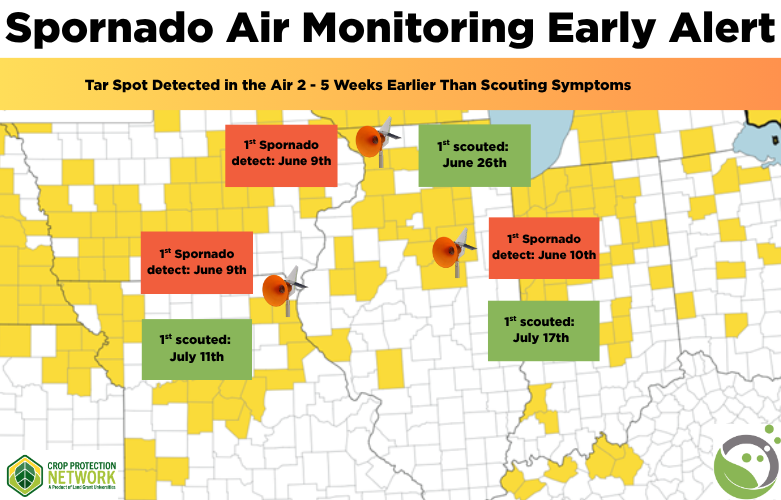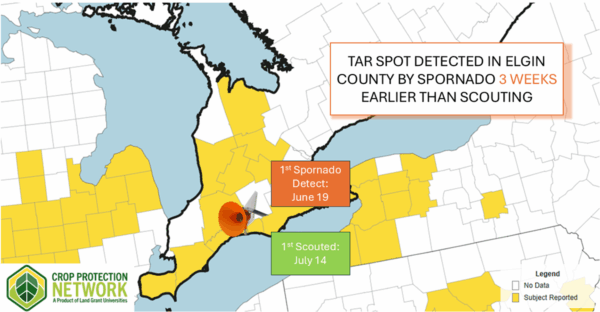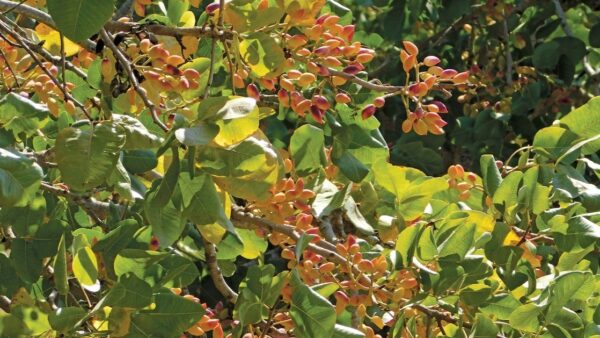In The News
When the Air Speaks First: What Spornado Tar Spot Air Monitoring Revealed in 2025
Tar spot (Phyllachora maydis) continues to be one of the most closely watched corn diseasesacross the U.S. Corn Belt. This season, Spornado samplers detected airborne tar spot sporesas early as early June, providing several weeks of early warning before field symptomsappeared.By early to mid-July, reports began confirming the first lesions in multiple states—closelyfollowing the environmental […]
Tar Spot in Ontario: 2025 Update
Tar spot continues to be a growing concern for Ontario corn growers, and 2025 has been no exception. This year, the disease followed a pattern similar to previous seasons—first appearing at low levels in early July in Elgin County. Hotter, drier summer conditions kept tar spot development relatively low until August, when more favorable weather […]
California’s Pest Management Shift: What It Means for Nut Growers and How to Prepare
California agriculture is entering a new phase in pest management. The California Department of Pesticide Regulation (DPR) is rolling out a Pesticide Prioritization Process as part of its Sustainable Pest Management (SPM) Roadmap , a move designed to reduce reliance on certain pesticide tools and accelerate adoption of lower-risk alternatives. Read the original National Nut […]
Rising Costs in Agriculture: How Sustainable Practices and Precision Tools Are Shaping the Future
As global agriculture faces increasing pressures, from rising input costs to the need for sustainable resource use, farmers are finding new ways to adapt. Insights from McKinsey’s Global Farmer Insights 2024 report shed light on key strategies farmers are using to manage these challenges: adopting sustainable practices, leveraging precision agriculture, and integrating tech-driven tools to […]
Navigating Tar Spot in Corn: The Value of Effective Management Strategies
Tar Spot, a devastating disease affecting corn crops, continues to challenge farmers across North America. With the recent surge in cases, understanding the disease’s impact and evaluating management strategies is crucial for maintaining yield and profitability. This blog explores the importance of timely intervention, the potential benefits of multiple fungicide applications, and the latest research […]
Beyond the Microscope: Exploring the Power of Molecular Diagnostics and 24/7 Sampling
Using molecular diagnostics to identify fungal spores provides several benefits over traditional microscopic analysis. The main advantage is accuracy of identification and species differentiation. Species level identification is not generally possible from a spore alone. Most spore analysts identify to the genus level only as this is all that is reliable. For example, the genus […]
How Spore Trapping Can Help Your Farm
Many significant fungal diseases that affect the most commercially important crops are dispersed via the air as part of their reproductive cycle. The practice of air sampling and spore trapping has long existed for variety reasons, including epidemiology, indoor environmental health, pollen indices and agricultural disease risk assessments. Simply put, spore trapping is the practice […]
Soil Health and Fungicides
Fungicides are an essential tool in agriculture, but their use can have negative impacts on the environment and even the crops they are designed to help. One environmental risk of fungicide use is the impact on soil health, particularly on beneficial fungi. Fungi play a crucial role in soil health by breaking down organic matter, […]
Potato & Tomato: A summary of important Fungal Diseases
“Why did the potato go on a date with the tomato? Because it wanted to ‘ketchup’!” Potato and tomato are not only a great pairing to eat, but they are also two of the crops that Spornado is highly focused on. Potato diseases can have a significant effect on yields and costs associated with potato production. […]
Fungicide Resistance
Fungicides are a valuable tool in the fight against fungal diseases, however, their extensive use has led to the development of fungicide-resistant strains of fungi. This means that the fungicides that once worked effectively against these fungi are now ineffective. This is becoming a large concern in the world of agriculture as some common fungicides […]









